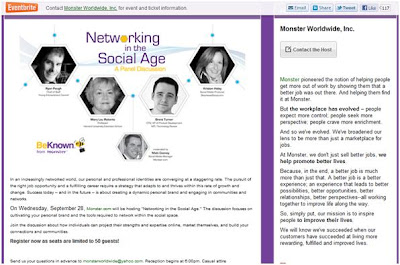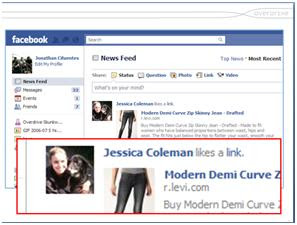Last night I had the pleasure—and fun—of being part of the Networking in the Social Age event hosted by Monster’s new BeKnown Network. It was moderated by Matt Cooney, Social Media Manager at Monster and, I’m happy to note, my former student. Joining me on the panel was a group of young, talented, social media pros: Ryan Paugh, Chief of Staff of the Young Entrepreneur Council, Brent Turner, CTO and VP Product Development at MIT’s Technology Review and Kristen Haley, Social Media Producer for Beantown Social. All of them are experienced in several aspects of the social media world and deeply engaged in it. The panel discussion was live-streamed on the BeKnown Network and I expect it to be archived there soon.
The discussion provided a lot of interesting insights. The most compelling one for me was the sense that, while the large social networks have their place, smaller and more intimate communities may be the wave of the future. Whether it’s a closed Facebook page, or a professional group on LinkedIn—open or closed—or whether it’s a community on any platform of people who are passionate about a subject, these smaller communities have a lot to offer both personally and professionally. @profstrahler Tweeted during the live stream and he pointed out some of the other high points. Thanks, Doug!
It was a good event, the first of many by this new network, I hope. I’ve always worked to help my students prepare for their job searches and career development; having a resource like BeKnown should be a real asset. Take a look at their mission statement on the sidebar of the event notice. Expanding the notion of job search to one of career management that helps people improve their lives is a great vision. The tight integration of the network with Facebook is going to provide a lot of opportunity. The BeKnown landing page has a great video introduction; it is an interesting perspective on merging your personal and professional communications and still controlling messages so they are directed to only the people you want to receive them. Of course they have a mobile app so you can do this on the go, and do it in many languages. Fascinating concept!
I look forward to watching this develop and seeing ways it can benefit today’s students and young professionals. Good going!
Thursday, September 29, 2011
BeKnown to Promote Your Career
Posted by MaryLou Roberts at 12:08 PM 1 comments
Labels: mobile apps, offline events, online events, social applications, social media, social media careers
Wednesday, September 14, 2011
Discovering the Facebook Like Button
Harry Gold, CEO of Overdrive Interactive, gave a great guest lecture in my SMM class last week. The wide-ranging presentation was based on his Advanced Social Media Marketing seminar. I can’t do justice to the entire presentation, but there was one part that particularly struck me.
I’ve seen the Facebook Like button on web pages and thought, “Isn’t that cute?” Well it turns out that it’s a lot more than cute; it essentially makes a Facebook fan page out of every product to which it’s attached.
A recent study of brand-related Facebook behavior for Constant Contact by Chadwick Martin Bailey has stunning data. Here are some key factoids:
• 78% of people who like brands like fewer than 10, so they are engaged with those brands.
• They mostly read brands’ posts and newsfeeds.
• 51% of fans are more likely to buy the brand
• 56% are more likely to recommend the brand to a friend after becoming a fan.
As you might expect, 59% don’t interact with brands on the big social nets but 56% of people under 35 do, and it’s primarily on Facebook. Don’t ignore older demographics; they may be more loyal and more likely to purchase. Check it out for yourself.
The Facebook Like button for web pages has been around since March 2010 but some quick research says that many sites like retailers who target teens and young adults aren’t yet taking advantage of it. Levis is a brand that gets it. Here’s what you need to know.
First, you don’t put the Like button on a home page or a page with multiple product thumbnails. I suppose you could, but it would be meaningless because there are multiple items of content and the “likes” would be meaningless. Encourage viewers to like your brand; that is valuable as the CMB data shows. In the case of individual Like buttons, you want them to like a single product like the skinny jeans pictured. Now that jean product has its own fan page!
When a visitor likes the product is when the action begins. As Harry’s illustration shows, the user activity shows up on the Facebook News Feed of her friends, with detailed information about the product and a link back to the product detail page. That’s already great visibility, but there’s more! Now the marketer can easily message the likers. That goes to their News Feeds, thereby reaching their friends. That is huge! Inside Facebook says,
Millions of websites and social games have implemented Facebook’s Like button social plugin, yet relatively few are taking advantage of the capability to publish news feed stories to users that click buttons that represent real-world objects. That creates a lot of capacity to reach fans and friends of fans that marketers like Levis are beginning to use.
Surprise, surprise—there’s a privacy issue also! The tool allows Facebook to collect web browsing data for its likers; this WSJ article has a link to all the articles in their What They Know series, which is excellent. The collection of user data has come to the attention of the authorities in Germany where it has been declared illegal in one German state. Wonder who will be right about privacy concerns about Facebook in the end—Zuckerberg or Germany?
In case you were wondering, Google is following a similar path with its +1 button. That adds another tool, which shows up in a number of places including search rankings for friends identified on the user’s Google profile. Apparently if you want to it to go to one of your Google+ circles, you have to share it manually—for now at least.
Marketers may need to exercise some caution in communicating with likers. In particular, all the data seems to agree that you shouldn’t overwhelm even your best friends with posts. Make them relevant and control the frequency.
This is fascinating stuff! Many thanks to Harry Gold for bringing it to my attention!
Posted by MaryLou Roberts at 11:27 AM 0 comments
Labels: brand evangelists, brand loyalty, Facebook, Facebook Likes, Google +1 button, Google+
Wednesday, September 7, 2011
Do You Believe Zuckerberg's Law of Social Sharing?
It’s being equated to Moore’s Law of early Internet days; the now-validated prediction that computing power will double every two years as costs fall by half. I don’t know whether it meets that standard, but here’s what Zuckerberg originally said in 2008:
“I would expect that next year, people will share twice as much information as they share this year, and next year, they will be sharing twice as much as they did the year before,” he said. “That means that people are using Facebook, and the applications and the ecosystem, more and more.”
My attention was drawn to this by a recent infographic on a Bloomberg Business Week site—more about that in a minute. The infographic is too large to reproduce easily, but it has some interesting factoids. Of course, the growth numbers are based on the Z. prediction; it’s not clear whether they used actual Facebook numbers to validate them. Whether the sharing figures are accurate (and who could tell with precision anyway??) the phenomenon is real. I found some other interesting things while looking around.
The consumer behavior behind sharing is important. There is a recent study by Nielsen for AOL that is worth paging through. Among other things, it finds that email is still the most-used sharing tool although social networks, especially Facebook, are gaining fast. Most Internet users share but they share different content on different networks. That’s interesting and important to the marketer who wants to have her content shared.
 The difficulty of doing that was brought home to me by this chart. It is the multichannel options for the ShareThis multichannel bar. I use the simple icon on this site and it’s reliable and it produces interesting analytics. They’ve also added a real-time widget that other bloggers or website owners might enjoy. There are a lot of options here: how does the marketer select the best ones? Start with any analytics you can get. You might want to test different options of a multichannel sharing bar, although you don’t want to confuse your visitors. Finally, you might resort to marketing research among key users or the most avid sharers on your site. You have to understand the behavior of your own target audience.
The difficulty of doing that was brought home to me by this chart. It is the multichannel options for the ShareThis multichannel bar. I use the simple icon on this site and it’s reliable and it produces interesting analytics. They’ve also added a real-time widget that other bloggers or website owners might enjoy. There are a lot of options here: how does the marketer select the best ones? Start with any analytics you can get. You might want to test different options of a multichannel sharing bar, although you don’t want to confuse your visitors. Finally, you might resort to marketing research among key users or the most avid sharers on your site. You have to understand the behavior of your own target audience.Marketers also struggle every day with issues of keeping up with their discipline, given the torrent of content. I ran into two interesting services. The infographic I referred to was created by Summify, a personal service that creates a daily summary of news from the user’s social networks and sends it by email, to the desktop, or by mobile. The infographic was posted on a BBW beta site called Business Exchange. It describes itself as a social sharing site, with items “filtered by like-minded professionals.” Those professionals can view, comment, and suggest new topics. I don’t see a distribution tool, but if there’s not one, it will probably come.
These services represent two different and interesting approaches to taming the torrent of social sharing. They fall short, however, of actual content curation, adding expert judgement to the equation, as practiced by Huffington Post and others.
It’s a big world, full of content. The job of marketers is to make their content entertaining, relevant, and worthy of social sharing. A big job indeed!
Posted by MaryLou Roberts at 10:05 AM 0 comments
Labels: content, content marketing, social media, social media behaviors, social networks, social sharing
Thursday, September 1, 2011
Falling into Social Media and Internet Marketing
Wow; it's September 1 already, in case you haven't noticed! Where did the summer go??? A hurricane that thankfully did less damage here than other places and a lot of work on a text that is coming well and hopefully will be ready for use in the spring semester. Debra and I feel strongly that the Internet is changing so rapidly that we have to keep the book as current as possible--hard as you can guess!
I'm back to thinking about social media strategy. This presentation has some updated thinking and data. I'll return especially to inbound and content marketing and metrics over the near future. In the meantime, enjoy a wonderful Labor Day weekend!
Posted by MaryLou Roberts at 11:32 AM 0 comments


